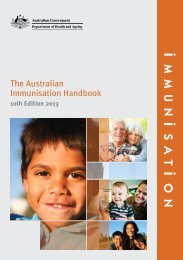3.30 MB - Academy of Medicine of Malaysia
3.30 MB - Academy of Medicine of Malaysia
3.30 MB - Academy of Medicine of Malaysia
Create successful ePaper yourself
Turn your PDF publications into a flip-book with our unique Google optimized e-Paper software.
MANAGEMENT OF HIV INFECTION IN CHILDREN<br />
In <strong>Malaysia</strong>, limited paediatric formulations have been made available by the<br />
MOH free <strong>of</strong> charge for patients and have enabled the provision <strong>of</strong> at least<br />
first and second line ARV drugs for children.<br />
Ongoing advances and research in PMTCT and the development <strong>of</strong> new<br />
ARV drugs and improvements in strategies <strong>of</strong> ARV management are<br />
occurring at rapid pace. Major online references are provided and the<br />
reader is advised to look these up to obtain the latest data and information<br />
on advances in HIV in children and adolescents.<br />
This CPG addresses two broad clinical areas.<br />
• The management <strong>of</strong> the infant with perinatal exposure to HIV infection<br />
• The management <strong>of</strong> HIV infection in children and adolescents.<br />
2. MANAGEMENT OF THE PERINATALLY EXPOSED INFANT<br />
2.1 HIV PROPHYLAXIS<br />
PREVENTION OF MOTHER -TO- CHILD TRANSMISSION (PMTCT)<br />
In the absence <strong>of</strong> any intervention, the risk <strong>of</strong> MTCT is between 15 and 45%.<br />
However, several effective prevention measures have been identified that<br />
can reduce the transmission rate to less than 2%. These interventions<br />
include ARV prophylaxis or HAART given to HIV-1 infected pregnant<br />
mothers, ARV prophylaxis for their newborn babies, safer approaches to<br />
delivery (including elective caesarean section) and total substitution <strong>of</strong><br />
breastfeeding with infant formula.<br />
The Pediatric AIDS Clinical Trials Group (PACTG 076) protocol 4, Level 2 was the<br />
first major study to demonstrate the effectiveness <strong>of</strong> a 3-part (antenatal,<br />
intrapartum and neonatal) ZDV prophylactic regimen in reducing the MTCT<br />
by 68%. The protocol was rapidly adopted by many countries (including<br />
<strong>Malaysia</strong> in 1998), resulting in significant reduction in numbers <strong>of</strong> infected<br />
infants. Over the years, many more trials have been conducted to evaluate<br />
different ARV prophylactic regimens to reduce MTCT both in breastfeeding<br />
and non-breastfeeding populations. These trials have confirmed the efficacy<br />
<strong>of</strong> various regimens including ZDV alone,<br />
2<br />
5, Level 2; 6, Level 2; 7, Level 2; 8 Level 2; 9, Level 2; 10, Level<br />
6; 11, Level 1 , ZDV + Lamivudine (3TC) 12,Level 2; 13 Level 2;14, Level 2; 15, Level 6 , single-dose<br />
nevirapine (sdNVP) 16, Level 2; 17, Level 2 and more recently, combinations <strong>of</strong> ZDV +<br />
sdNVP 18, Level 2; 19, Level 6 , ZDV + 3TC + sdNVP 22, Level 9 and triple ART/HAART.<br />
20, Level 6; 21, Level 6 .<br />
Although several ARV regimens have been studied using different durations<br />
<strong>of</strong> either single or combined drugs, questions still remain regarding which<br />
regimen is the best in achieving the largest reduction in MTCT. Direct<br />
comparisons between studies are <strong>of</strong>ten difficult as studies are done using<br />
various methodologies and are conducted in different study populations.

















